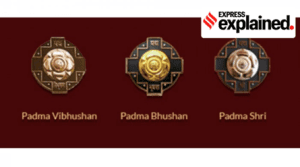TAG: GS 2: POLITY
THE CONTEXT: India’s Civilian Awards stand as symbols of appreciation and honor, acknowledging individuals for their outstanding achievements across diverse professions.
EXPLANATION:
- Awards are symbols of appreciation and honour bestowed on individuals with notable achievements in diverse professions.
- Article 18 talks about the abolition of titles. It says: No title, not being a military or academic distinction, shall be conferred by the State. No citizen of India shall accept any title from any foreign State.
- But Bharat Ratna is not a title under Article 18. Clause 1 of article 18 covers exceptions like academic or military titles.
- Awards like Padma Vibhushan, Padma Shri etc. can be given to the citizens for exceptional and distinguished services rendered in art, literature, science and other fields.
- Among the highest honours, India’s Civilian Awards, announced annually on January 26th, Republic Day, are presented to the respective recipients by the President of India.
- Civilian Awards are introduced in 1954, they recognize individuals for their exceptional service and contributions in various fields such as arts, literature, sports, medicine, social service, science, and public affairs.
- They are conferred to people with outstanding achievements in their field of work.
- Categorised as per the degree of honour, it includes the Bharat Ratna Award and the Padma Award.
Bharat Ratna: The Jewel of India
- The Bharat Ratna, also known as the ‘Jewel of India’ or ‘Gem of India’, is India’s highest civilian honour, bestowed upon individuals who have made exceptional contributions to the nation’s progress and prosperity.
- Established in 1954 by then-President Rajendra Prasad, it is made of bronze and designed in the shape of a peepal leaf, embossed with the sun.
- The reverse side bears India’s emblem, the ‘Ashok Chakra’, and the motto, ‘Satyameva Jayate’.
- Initially awarded for achievements in literature, science, the arts, and public services, the Indian government expanded the criteria in 2011, as it is a symbol of national gratitude and recognition, impacting India and its people through its contributions.
- This year Bharat Ratna award is to be conferred on:
- Karpoori Thakur: Prominent political leader in Bihar known for social justice efforts (Posthumous)
- Lal Krishna Advani: Veteran Indian politician instrumental in the growth of the Bharatiya Janata Party
- Chaudhary Charan Singh:Fifth Prime Minister of India, known for land reforms (Posthumous)
- PV Narasimha Rao: Former Prime Minister known for economic liberal reforms (Posthumous)
- Dr MS Swaminathan: Agricultural scientist, known as the ‘Father of Green Revolution’ in India (Posthumous)

Padma Vibhushan: The Second Degree of Honor
- The Padma Vibhushan (“Lotus Decoration”) is the second-highest civilian award of the Republic of India, after the Bharat Ratna.
- Instituted on 2 January 1954, the award is given for “exceptional and distinguished service”.
- All persons without distinction of race, occupation, position or sex are eligible for these awards.
- However, government servants including those working with PSUs, except doctors and scientists, are not eligible for these Awards.
Padma Bhushan: The Third Degree of Honor
- Ranking third in the hierarchy of civilian awards, Padma Bhushan was instituted in 1954 as well.
- It is awarded for distinguished service of a high order to the nation in any field, including services rendered by government servants like doctors and scientists, excluding those working with public sector undertakings.
- Having a similar design to the Padma Vibhushan, however, the Padma Bhushan’s embossing is done in gold.
Padma Shri: The Fourth Degree of Honor
- The fourth-highest civilian award in the Republic of India, Padma Shri, was instituted in 1954.
- It is given to Indian citizens in recognition of their outstanding contributions in a variety of fields, including the services provided by government employees.
- Having the shape of a superimposition of a geometric pattern on the circle, the words “Padma” and “Shri” are inscribed in the award, above and below the lotus flower in the centre, done in stainless steel, with the periphery furnished in bronze.


